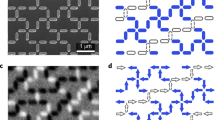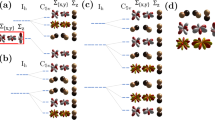Abstract
Artificial frustrated systems offer a playground to study the emergent properties of interacting systems. Most work to date has been on spatially periodic systems, known as artificial spin ices when the interacting elements are magnetic. Here we have studied artificial magnetic quasicrystals based on quasiperiodic Penrose tiling patterns of interacting nanomagnets. We construct a low-energy configuration from a step-by-step approach that we propose as a ground state. Topologically induced emergent frustration means that this configuration cannot be constructed from vertices in their ground states. It has two parts, a quasi-one-dimensional ‘skeleton’ that spans the entire pattern and is capable of long-range order, surrounding ‘flippable’ clusters of macrospins that lead to macroscopic degeneracy. Magnetic force microscopy imaging of Penrose tiling arrays revealed superdomains that are larger for more strongly coupled arrays, especially after annealing the array above its blocking temperature.
This is a preview of subscription content, access via your institution
Access options
Access Nature and 54 other Nature Portfolio journals
Get Nature+, our best-value online-access subscription
$29.99 / 30 days
cancel any time
Subscribe to this journal
Receive 12 print issues and online access
$209.00 per year
only $17.42 per issue
Buy this article
- Purchase on Springer Link
- Instant access to full article PDF
Prices may be subject to local taxes which are calculated during checkout





Similar content being viewed by others
References
Bernal, J. D. & Fowler, R. H. A theory of water and ionic solution, with particular reference to hydrogen and hydroxyl ions. J. Chem. Phys. 1, 515–548 (1933).
Harris, M. J., Bramwell, S. T., McMorrow, D. F., Zeiske, T. & Godfrey, K. W. Geometrical frustration in the ferromagnetic pyrochlore Ho2Ti2O7. Phys. Rev. Lett. 79, 2554–2557 (1997).
Wang, R. F. et al. Artificial ‘spin ice’ in a geometrically frustrated lattice of nanoscale ferromagnetic islands. Nature 439, 303–306 (2006).
Han, Y. et al. Geometric frustration in buckled colloidal monolayers. Nature 456, 898–903 (2008).
Latimer, M. L., Berdiyorov, G. R., Xiao, Z. L., Peeters, F. M. & Kwok, W. K. Realization of artificial ice systems for magnetic vortices in a superconducting MoGe thin film with patterned nanostructures. Phys. Rev. Lett. 111, 067001 (2013).
Ortiz-Ambriz, A. & Tierno, P. Engineering of frustration in colloidal artificial ices realized on microfeatured grooved lattices. Nat. Commun. 7, 10575 (2016).
Nisoli, C., Moessner, R. & Schiffer, P. Colloquium: Artificial spin ice: Designing and imaging magnetic frustration. Rev. Mod. Phys. 85, 1473 (2013).
Morgan, J., Stein, A., Langridge, S. & Marrows, C. H. Thermal ground state ordering and elementary excitations in artificial magnetic square ice. Nat. Phys. 7, 75–79 (2011).
Morgan, J. P. et al. Real and effective thermal equilibrium in artificial square spin ices. Phys. Rev. B 87, 024405 (2013).
Porro, J., Pinto, A., Berger, A. & Vavassori, P. Exploring thermally induced states in square artificial spin-ice arrays. New J. Phys. 15, 055012 (2013).
Farhan, A. et al. Direct observation of thermal relaxation in artificial spin ice. Phys. Rev. Lett. 111, 057204 (2013).
Kapaklis, V. et al. Thermal fluctuations in artificial spin ice. Nat. Nanotech. 9, 514–519 (2014).
Perrin, Y., Canals, B. & Rougemaille, N. Extensive degeneracy, Coulomb phase and magnetic monopoles in artificial square ice. Nature 540, 410–413 (2016).
Tanaka, M., Saitoh, E., Miyajima, H., Yamaoka, T. & Iye, Y. Domain structure and magnetic ice-order in NiFe nano-network with honeycomb structure. J. Appl. Phys. 97, 10J710 (2005).
Qi, Y., Brintlinger, T. & Cumings, J. Direct observation of the ice rule in an artificial kagome spin ice. Phys. Rev. B 77, 094418 (2008).
Ladak, S., Read, D. E., Perkins, G. K., Cohen, L. F. & Branford, W. R. Direct observation of magnetic monopole defects in an artificial spin-ice system. Nat. Phys. 6, 359–363 (2010).
Mengotti, E. et al. Real-space observation of emergent magnetic monopoles and associated Dirac strings in artificial kagome spin ice. Nat. Phys. 7, 68–74 (2011).
Rougemaille, N. et al. Artificial kagome arrays of nanomagnets: A frozen dipolar spin ice. Phys. Rev. Lett. 106, 057209 (2011).
Zhang, S. et al. Crystallites of magnetic charges in artificial spin ice. Nature 500, 553–557 (2013).
Möller, G. & Moessner, R. Magnetic multipole analysis of kagome and artificial ice dipolar arrays. Phys. Rev. B 80, 140409 (2009).
Chern, G.-W., Mellado, P. & Tchernyshyov, O. Two-stage ordering of spins in dipolar spin ice on the kagome lattice. Phys. Rev. Lett. 106, 207202 (2011).
Anghinolfi, L. et al. Thermodynamic phase transitions in a frustrated magnetic metamaterial. Nat. Commun. 6, 8278 (2015).
Nisoli, C. et al. Ground state lost but degeneracy found: the effective thermodynamics of ‘artificial spin ice’. Phys. Rev. Lett. 98, 217103 (2007).
Budrikis, Z. et al. Disorder strength and field-driven ground state domain formation in artificial spin ice: experiment, simulation and theory. Phys. Rev. Lett. 109, 037203 (2011).
Kapaklis, V. et al. Melting artificial spin ice. New J. Phys. 14, 035009 (2012).
Farhan, A. et al. Exploring hyper-cubic energy landscapes in thermally active finite spin-ice systems. Nat. Phys. 9, 375–382 (2013).
Chioar, I. A. et al. Kinetic pathways to the magnetic charge crystal in artificial dipolar spin ice. Phys. Rev. B 90, 220407 (2014).
Drisko, J., Daunheimer, S. & Cumings, J. FePd3 as a material for studying thermally active artificial spin ice systems. Phys. Rev. B 91, 224406 (2015).
Morley, S. A. et al. Vogel–Fulcher–Tammann freezing of a thermally fluctuating artificial spin ice probed by X-ray photon correlation spectroscopy. Phys. Rev. B 95, 104422 (2017).
Morrison, M. J., Nelson, T. R. & Nisoli, C. Unhappy vertices in artificial spin ice: new degeneracies from vertex frustration. New J. Phys. 15, 045009 (2013).
Gilbert, I. et al. Emergent ice rule and magnetic charge screening from vertex frustration in artificial spin ice. Nat. Phys. 10, 671–676 (2014).
Gilbert, I. et al. Emergent reduced dimensionality by vertex frustration in artificial spin ice. Nat. Phys. 12, 162–165 (2016).
Wang, Y.-L. et al. Rewritable artificial magnetic charge ice. Science 352, 962–966 (2016).
Shechtman, D., Blech, I., Gratias, D. & Cahn, J. W. Metallic phase with long-range orientational order and no translational symmetry. Phys. Rev. Lett. 53, 1951–1953 (1984).
Janot, C. Quasicrystals: A Primer (Clarendon, Oxford, 1992).
Charrier, B. & Schmitt, D. Dynamical and irreversible magnetic effects in Ir8Mg42Zn50 quasicrystals (R=Tb, Dy). J. Magn. Magn. Mater. 189, 165–172 (1998).
Islam, Z. et al. Reinvestigation of long-range magnetic ordering in icosahedral Tb-Mg-Zn. Phys. Rev. B 57, 11047–11050 (1998).
Sato, T. Short-range order and spin-glass-like freezing in a-mg-r (a=Zn or Cd; r=rare-earth elements) magnetic quasicrystals. Acta Cryst. A A61, 39–50 (2005).
Bhat, V. S. et al. Controlled magnetic reversal in permalloy films patterned into artificial quasicrystals. Phys. Rev. Lett. 111, 077201 (2013).
Farmer, B. et al. Direct imaging of coexisting ordered and frustrated sublattices in artificial ferromagnetic quasicrystals. Phys. Rev. B 93, 134428 (2016).
Brajuskovic, V., Barrows, F., Phatak, C. & Petford-Long, A. K. Real-space observation of magnetic excitations and avalanche behavior in artificial quasicrystal lattices. Sci. Rep. 6, 34384 (2016).
Vedmedenko, E. Y., Oepen, H. P. & Kirschner, J. Decagonal quasiferromagnetic microstructure on the Penrose tiling. Phys. Rev. Lett. 90, 137203 (2003).
Nisoli, C. On thermalization of magnetic nano-arrays at fabrication. New J. Phys. 14, 035017 (2012).
Wang, R. F. et al. Demagnetization protocols for frustrated interacting nanomagnet arrays. J. Appl. Phys. 101, 09J104 (2007).
Donahue, M. J. & Porter, D. G. OOMMF User’s Guide, Version 1.0. Interagency Report NISTIR 6376 (National Institute of Standards and Technology, Gaithersburg, MD, 1999); http://math/nist.gov/oommf
Gummelt, P. Penrose tilings as coverings of congruent decagons. Geometriae Dedicata 62, 1–17 (1996).
Vedmedenko, E. Y., Grimm, U. & Wiesendanger, R. Noncollinear magnetic order in quasicrystals. Phys. Rev. Lett. 93, 076407 (2004).
Ke, X. et al. Energy minimization and ac demagnetization in a nanomagnet array. Phys. Rev. Lett. 101, 037205 (2008).
Osborn, J. A. Demagnetizing factors of the general ellipsoid. Phys. Rev. 67, 351–357 (1945).
Morgan, J. P., Bellew, A., Stein, A., Langridge, S. & Marrows, C. H. Linear field demagnetization of artificial magnetic square ice. Front. Phys. 1, 28 (2013).
Acknowledgements
This research used resources of the Center for Functional Nanomaterials, which is a US DOE Office of Science Facility, at Brookhaven National Laboratory under Contract No. DE-SC0012704, and was also supported by the EPSRC (grant EP/L00285X/1). Z.B. was supported by the ERC Advanced Grant no. 291002 SIZEFFECTS.
Author information
Authors and Affiliations
Contributions
C.H.M. conceived the project. A.S. fabricated the samples, using Penrose array designs made by G.B. and D.S. D.S. performed the MFM imaging and the a.c.-demagnetization and thermal annealling protocols, analysed the data (using software co-designed with G.B.) and theoretically derived the expected ground state. Z.B. performed the Monte Carlo simulations in consultation with D.S. S.A.M. performed the SQUID magnetometry measurements. C.H.M., G.B. and P.D.O. supervised the work. All authors discussed the data and commented on the manuscript.
Corresponding author
Ethics declarations
Competing interests
The authors declare no competing financial interests.
Additional information
Publisher’s note: Springer Nature remains neutral with regard to jurisdictional claims in published maps and institutional affiliations.
Electronic supplementary material
Supplementary Information
Supplementary notes 1-7, Supplementary Figures 1-14, and Supplementary References 1-15
Rights and permissions
About this article
Cite this article
Shi, D., Budrikis, Z., Stein, A. et al. Frustration and thermalization in an artificial magnetic quasicrystal. Nature Phys 14, 309–314 (2018). https://doi.org/10.1038/s41567-017-0009-4
Received:
Accepted:
Published:
Issue Date:
DOI: https://doi.org/10.1038/s41567-017-0009-4
This article is cited by
-
Unveiling multipole physics and frustration of icosahedral magnetic quasicrystals
npj Quantum Materials (2024)
-
Spin dynamics, loop formation and cooperative reversal in artificial quasicrystals with tailored exchange coupling
Communications Physics (2023)
-
Searching for the ground state of complex spin-ice systems using deep learning techniques
Scientific Reports (2022)
-
String Phase in an Artificial Spin Ice
Nature Communications (2021)
-
Effect of Ti4+ Substitution on Microstructure and Magnetic Order of Ca3CoMn1-xTixO6
Journal of Superconductivity and Novel Magnetism (2020)



